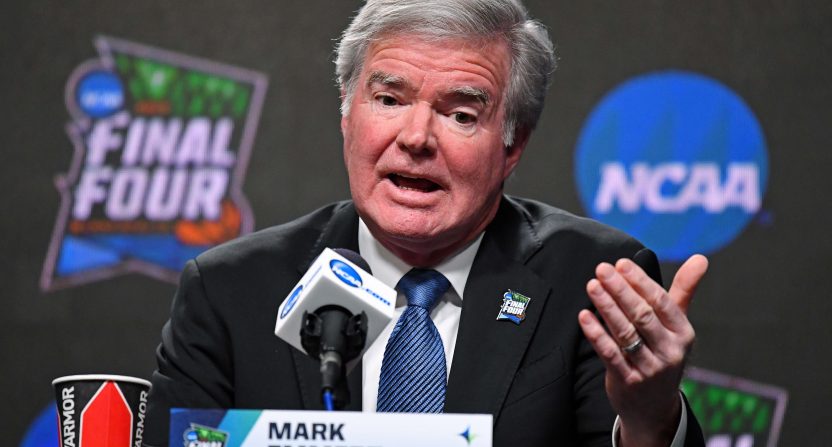The idea of NCAA athletes at least having the opportunity to profit from their image rights (the way other students can) is gaining momentum, with California passing a law on that front (even if it doesn’t go into effect until 2023), other state and federal legislators contemplating similar legislation, and even the NCAA and president Mark Emmert (seen above) shifting their official tone from threatening to ban California schools from national championships (a not-terribly-believable threat) to instead moving to “immediately consider updates” to their own image rights rules (even if that may not actually lead to much).
That’s tied into other discussions about ways to compensate players, and to the larger debate about amateurism (which former Alabama QB and ESPN CFB analyst Greg McElroy called “a farce at this point” Tuesday). There’s still a whole lot to be determined about what (if any) changes will actually come here and what that will mean for athletes, but an interesting sidenote of this is that the player compensation discussion is now being cited as one of the most prominent factors in any further conference realignment.
Conference realignment overall has died down significantly from the massive changes of 2010-14, and there aren’t any obvious moves ahead for any of the Power 5 conferences; there aren’t a lot of great expansion options outside the P5 ranks right now, and there don’t appear to be too many P5 schools looking to change conferences (or conferences looking to add other P5 conferences’ schools, for that matter). There has been some talk that the next round of media rights deals might change that, especially if conferences’ financial situations start to drastically diverge, but that talk’s still pretty muted at this point.
However, an anonymous media executive commenting to Jon Wilner of The San Jose Mercury News (for the final part of an ongoing series Wilner has been doing on the future of the Pac-12) suggested that there are current conversations that conference realignment might happen not over media deals, but rather based on how further player compensation winds up being implemented. The executive said some current P5 schools may go to the highest levels allowed (whatever those may wind up being) and others may stay at lower levels (or provide none at all), and that could lead to conference splits.
“Are the students getting paid? And are they getting paid across the board, or just the schools that can afford it,” said the media executive.
“There are conversations going on right now about how you might split the top five (conferences) in two.
“And if you’re a media company and you get the top 30 schools to play each other every Saturday, that looks a lot like the NFL.”
Wilner’s piece also closes with a quote from an anonymous industry analyst, who says “The Power Five seceding from the NCAA is more likely than media rights sparking realignment.” That’s not necessarily the exact kind of split the media executive is mentioning (it would be more of a separation of the P5 and the Group of Five rather than division within the existing P5), but it speaks to the larger point that if some enhanced player-compensation framework comes in, that could lead to different realignment scenarios, and that player-compensation changes might be more likely to trigger realignment than anything else at the moment.
It’s unclear that this kind of “top 30 schools” idea would actually be great for the media side, though. First, that means you’ve gone from at least five highly-desirable conference packages to one or two. And second, you’ve removed a lot of the potential giant upsets and the higher meaning on each regular-season game, both elements that attract a lot of people to college football. So even if we do wind up with conference fragmentation, it’s not necessarily going to play out exactly that way.
And it should be noted that at the moment, this is all extremely hypothetical. There’s very little to go on so far on what a national framework for enhanced player compensation will look like, or if there will even be one; it’s quite possible that this could wind up differing state-by-state. And image rights alone might not necessarily lead to Power 5 conferences splitting further into haves and have-nots.
First, those conferences all already contain haves and have-nots; Alabama has a few more national football titles than Vanderbilt or Kentucky, and already has a recruiting edge against those schools. And second, image rights might actually help boost some of the smaller schools in attracting top players at skill positions; for example, we already see a lot of quarterbacks transfer to try and start somewhere else, and that might get even more attractive if they can get starting QB endorsement deals even at a less-prominent school. It’s not clear at all that bringing in image rights or other enhanced compensation will dramatically alter the existing balances of power, and it’s not clear that even a balance of power shift would be enough to alter conferences the way this executive is describing. So none of this should be taken as “The sky is totally falling, and any kind of enhanced player compensation will absolutely blow up today’s conferences.”
But with that said, it’s interesting to hear that there’s already talk out there about potential conference splits over compensation issues. And it’s interesting to hear that this is now being flagged as a bigger factor in any potential realignment than media rights contracts. And that will make it highly worth tracking the progress of the compensation debate as we approach the next rounds of conferences’ media rights negotiations.







